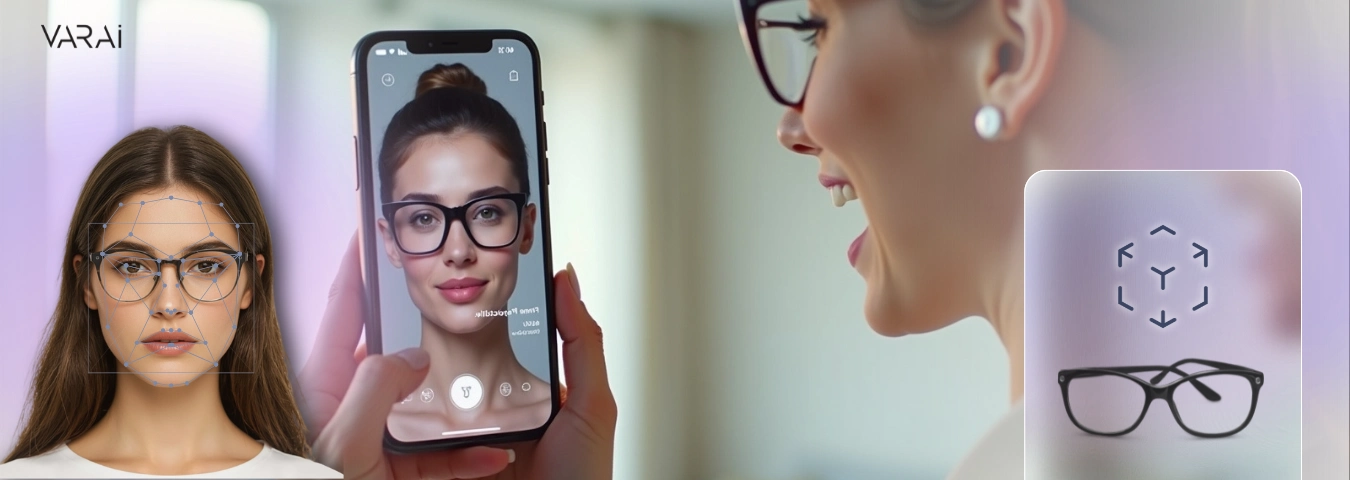Any eyewear website you visit today is shining its most powerful tool at you, AR tech. Most people get confused, but the technology behind your virtual try-ons is actually augmented reality. It overlays the computer generated digital content, in this case eyeglasses, on top of your live feed.
But, is this technology as revolutionized for an online eyewear brand as it seems? In this blog we will cover does AR help eyewear ecommerce businesses or not. We will also list some e-commerce marketplaces that can accommodate your AR virtual try on needs.
Let’s begin!
What Do Augmented Reality Statistics in Eyewear Say?
Augmented Reality (AR) eyewear is rapidly shaping the future of retail, gaming, healthcare, and enterprise solutions. With over 100 million AR users in the U.S. alone by 2025, and one in seven people globally using AR, adoption is growing fast.
Retailers are especially leaning in. 80% of global retailers are expected to implement AR by 2025, with 61% of consumers preferring brands that offer AR experiences, leading to conversion rate increases of up to 90%. In the UK, 72% of luxury fashion shoppers now expect AR integration.
Market growth is accelerating. AR glasses revenue will rise from $1.85 billion in 2021 to $23.27 billion in 2025, and up to $35.06 billion by 2026. The broader AR/VR eyewear sector is projected to hit $41.6 billion by 2029, while smart eyewear overall could exceed $98 billion by 2034.
In the U.S., 100.1 million people used AR in 2025, with that number expected to rise to 106.9 million by 2027. By 2025, 35 to 40% of internet users, around 60% of the population, will regularly engage with AR, driven by retail integration and mobile accessibility. This widespread usage is often referenced in government digital economy reports and forms a solid foundation for AR eyewear adoption.
AR eyewear is gaining traction not just among consumers, but also across industries. Backed by innovation, investment, and evolving expectations, it’s quickly moving from novelty to necessity.
How Has AR Revolutionized Eyewear E-Commerce?
Augmented Reality (AR) has transformed eyewear e‑commerce by offering immersive try-on experiences. Globally, the AR e‑commerce market reached approximately $5.88 billion in 2024 and is projected to grow at a 35.8% CAGR through 2030. In North America, led by the U.S., over 25% of this market share in 2024 drove a 21% CAGR through 2025‑30.
In 2024, 55 to 60% of AR usage was in retail environments, with smart glasses driving virtual try-ons, reducing eyewear return rates by up to 35%. Most AR interactions still occur via mobile, but smart eyewear adoption, especially head‑mounted displays, is accelerating.
In the U.S., the AR and VR smart glasses industry was valued at $5.9 billion in 2024, growing at a 12.8% CAGR. The broader AR/VR eyewear market (including smart glasses) reached $45.6 billion in 2024 and is expected to exceed $50.8 billion by 2025.
For eyewear platforms, this means:
- Virtual try-on boosts consumer confidence and reduces sizing friction.
- Interactive product visualization, placed in 3D on users’ faces or in home environments, differentiates brands.
- Mobile AR integration remains key: over 60% of users engage via smartphones
These stats, often cited by national commerce and digital economy reports (e.g., U.S. Department of Commerce), show AR is rapidly moving from novelty to essential for eyewear e‑commerce. It’s not just enhancing the shopping experience; it’s reshaping conversion models and inventory optimization.
Top 6 E-Commerce Platforms and Plugins Supporting AR
If you have an online eyewear business, you may not always find an eyewear e-commerce software that allows you to integrate eyewear tools. However, if you are looking to switch from your ecommerce plugin to the next, here are the options you should consider:
1. WooCommerce (WordPress-Based AR Integration)

In recent times, WooCommerce has become one of the best plugin that integrates AR technology. It supports AR through plugins like “Augmented Reality for WordPress,” helping eyewear brands to provide immersive and virtual product experiences.
This plugin allows all visiting customers to interact with 3D eyewear models and try them on in a real-world setting on their smartphones, using the virtual try on feature they may have purchased from other brands. This plugin is best for small-to-midsize eyewear brands who already have a WordPress website.
Key Features:
- No-code or low-code plugin integration
- 3D and AR previews embedded on product pages
- Compatible with eyewear, fashion, furniture, and more
- Uses WebAR and is mobile-responsive
2. Shopify (Native AR Support)
Shopify is an e-commerce platform that allows for better AR support. As the website is an in-built ecommerce site, you can practically integrate anything from AR tech to product pages in mere hours. For eyewear brands specifically, there is a Shopify AR Quick Look Feature.
This allows your site to present your products in 3D model form in augmented reality for live interactions. Shopify supports this feature through web browser on iOS 12+ devices. However, you can also install plug and play supports to allow custom AR tech to integrate with your ecommerce eyewear website. Both, independent eyewear retailers and large ecommerce eyewear brands can take advantage of this in-built feature.
Benefits:
- Built-in AR support with no third-party plugin needed
- Supports USDZ and glTF 3D file formats
- Mobile-friendly with seamless Apple ARKit integration
- Boosts conversion rates and reduces return rates
3. Magento (Adobe Commerce AR Tools)
You can manage and build your online eyewear ecommerce store using Magento. This open source platform has special extensions like ARitize™ or allows integration of other enterprise-grade third-party solutions. If you want high-performing eyewear AR tools, you can integrate extensions like VARAi’s virtual try on.
Also, the tools help product pages perform better and attract customers. The 3D model viewing capabilities and spacial placement features are especially helpful for eyewear brands. You can create custom commerce environments that help with showcasing these AR tools in the best way possible.
Features Include:
- Interactive product viewing in 3D or AR
- Built for large catalogs and complex product types
- Extension-based flexibility for various AR experiences
- Enterprise-ready integration and support
4. BigCommerce (API-Based AR Integration)
BigCommerce is another ecommerce platform that allows for custom integrations. While, other platforms have their own plugins or extensions, BigCommerce support other third-party plugins and APIs. For example, if you have an in-house website developer, you can create custom APIs for Augmented Reality which the platform supports.
While it lacks a built-in AR tool like Shopify, its open architecture allows eyewear brands to plug in powerful AR features. Especially, if you are a mid-sized online eyewear brand, you can push unique AR features to make yourself stand out in the eyewear market.
Application Scenarios:
- Use APIs to integrate virtual try-on tools
- Add 3D models for enhanced product previews
- Works well for omnichannel eyewear retailers
- Supports emerging AR tools like VARAi
5. Salesforce Commerce Cloud (Enterprise AR Enablement)
Salesforce Commerce Cloud has enterprise-grade AR capacities. As it also acts as a CRM (Customer Relationship Management), most eyewear brands at international levels or with multi-store (online and physical both) volumes prefer to set up their website through Salesforce.
Remember, that retailers can integrate AR or VR toolkits directly or via preferred vendors. If you want to integrate VARAi’s AR tool, virtual try on, you can by integrating the plugin. However, only choose this option if you have AR with CRM, AI, and data personalization needs as it can be costly.
Enterprise AR Capabilities:
- Built-in hooks for AR/VR customization
- Suitable for high-volume eyewear stores
- Supports AI-powered product personalization
- Enables scalable digital experiences across web and mobile
6. Custom Plug-and-Play AR Solutions by VARAi (Cross-Platform Integration)
VARAi offers a range of plug-and-play AR solutions that can be seamlessly integrated into any ecommerce ecosystem. From Virtual Try-On to PD measurement calculator and AI-based recommendations, every module is designed to deliver hyper-personalized, real-time experiences across platforms, without the need for complex coding or platform limitations.
Whether you’re using Shopify, Magento, WooCommerce, or a custom-built system, VARAi’s modular tech stack ensures consistent, device-agnostic performance.
These solutions are tailored for scalability, making them ideal for businesses of all sizes, from eyewear startups to global retail chains. Backed by proprietary rendering engines and AI models, VARAi helps ecommerce brands bring eyewear to life online while cutting costs, reducing returns, and increasing conversions.
Augment (Cloud-Based AR Product Visualization Tool):
- API-based integration for fast, lightweight deployment.
- Supports real-time 3D product previews on web and mobile.
- Offers white-labeled branded AR viewers.
- Ideal for non-technical teams needing fast implementation.
VARAi’s Plug-and-Play AR Solutions Include:
- Virtual Try-On (VTO): AI-enhanced, ultra-realistic eyewear fitting with real-time alignment, accurate occlusion, and full compatibility across platforms and devices.
- Pupillary Distance (PD) Calculator: Accurate to within <1.5 mm, this browser-based tool requires no physical props and integrates easily into any VTO or checkout workflow.
- AI Eyewear Recommendation Engine: Analyzes face shape and style preferences to recommend the perfect frame match—driving personalization and customer satisfaction.
What’s Next?
AR is the essential tech that is being used in eyewear e-commerce, and it won’t slow down anytime soon. As more and more businesses shift online, technologies like augmented reality help businesses connect with customers using their products realistically.
However, every plugin may not be the best solution for your eyewear ecommerce business. Hence, we suggest you try VARAi’s AR solutions, like virtual try on, PD measurement calculator, and AI-eyewear recommender to help your business thrive in a competitive market.
Reach out to us here to see what our eyewear digital solutions can do for your business.

